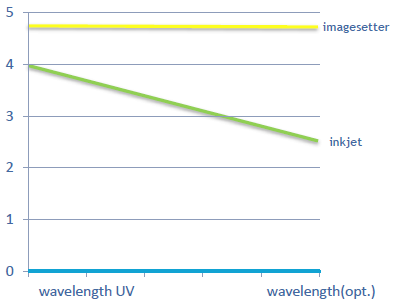Hello and welcome to our guide for the linearization assistant. Since the process contains many steps and every user has a different background knowledge and/or experience with our software this guide is divided into 3 parts. This way we ensure that you can just skip to the part where you need some more information or hints.
Let’s start with the first part which will focus on the density and the measurement devices which are required to do the linearization.
There are 2 different densities. One is describing the optical density. This density is defined by the wavelength that our human eye can detect. The other density is the UV density and is the important one we need for a good exposure. This is defined by ultraviolet wavelength, which is definitely invisible for the human eye. In the past everyone was used to work with imagesetter film, with a high optical density which is more or less the same like the UV density. Normally customers are used to check density of a film with their eyes. This is not working with inkjet films as the optical density is low but the UV density is high.
For a better understanding just think about the sunglasses. They protect our eyes from UV rays by having a good UV density (UV 400) but we can still look through it!
What does this mean for the screen film production?
- Your optical measurement device will only measure opt. density. So you will get values that seem to be too low. As a thumb rule for all inkjet inks, you can at least add 1.2-1.5 to your measured density to get the UV density.
- This is no disadvantage, just a characteristic, but we need to keep this in our mind to take the right decisions within our linearization.
- A UV density of 3.0+ (screen printing) is required for a successful exposure.
Most devices only support the optical measurements and this is enough for the linearization. Important is to be able to measure optical dot coverage in percentage, as we need to fill in these values later during the linearization. Having another measurement device for measuring the UV density would be helpful for choosing the ideal ink amount, but is not needed, because we have the thumb rule of adding 1.2-1.5 to the measured optical density.
The following measurement devices have been tested and used for the linearization (others might also work):
- IC Film – Gretag MacBeth (not longer produced)
- D200 – Gretag MacBeth (not longer produced)
- Xrite – 341/341C
- Xrite – 361T
- Techkon – RT120






